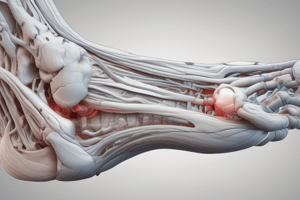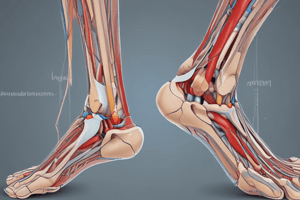Podcast
Questions and Answers
What anatomical structure is primarily responsible for limiting arthrokinematic motion in the foot and ankle?
What anatomical structure is primarily responsible for limiting arthrokinematic motion in the foot and ankle?
- Achilles tendon
- Lateral malleolus
- Plantar fascia
- Talocrural joint (correct)
Which of the following conditions is directly related to the presence of a dropped arch?
Which of the following conditions is directly related to the presence of a dropped arch?
- Knee Osteoarthritis
- Hallux Valgus
- Pes Cavus
- Pes Planus (correct)
In terms of muscle activity, which muscle group is most involved in osteokinematic motion of the ankle during dorsiflexion?
In terms of muscle activity, which muscle group is most involved in osteokinematic motion of the ankle during dorsiflexion?
- Gastrocnemius
- Soleus
- Tibialis anterior (correct)
- Peroneus longus
How does the convex-concave principle apply to arthrokinematic motion in the ankle joint?
How does the convex-concave principle apply to arthrokinematic motion in the ankle joint?
What biomechanical consideration is often associated with foot deformities like pes cavus?
What biomechanical consideration is often associated with foot deformities like pes cavus?
What is the primary function of the foot/ankle during the stance phase of gait?
What is the primary function of the foot/ankle during the stance phase of gait?
Which type of joints primarily allow for plantarflexion and dorsiflexion?
Which type of joints primarily allow for plantarflexion and dorsiflexion?
What common injuries affect the foot and ankle?
What common injuries affect the foot and ankle?
Which motions are combined during supination and pronation of the foot?
Which motions are combined during supination and pronation of the foot?
What is emphasized in the osteokinematic motion focus?
What is emphasized in the osteokinematic motion focus?
What structure limits or causes arthrokinematic motion in the foot and ankle?
What structure limits or causes arthrokinematic motion in the foot and ankle?
Which of the following best describes the number of bones in the foot/ankle?
Which of the following best describes the number of bones in the foot/ankle?
What is a characteristic feature of the axes involved in foot motion?
What is a characteristic feature of the axes involved in foot motion?
Flashcards
Foot/Ankle Function
Foot/Ankle Function
The foot and ankle act as a mobile adaptor and rigid lever during gait, within one second.
Ankle Injuries
Ankle Injuries
Common orthopedic injuries affecting the ankle
Talocrural Joint
Talocrural Joint
Joint between tibia, fibula, and talus; responsible for dorsiflexion and plantarflexion (up and down movement).
Subtalar Joint
Subtalar Joint
Signup and view all the flashcards
Osteokinematics
Osteokinematics
Signup and view all the flashcards
Arthrokinematics
Arthrokinematics
Signup and view all the flashcards
Plantarflexion
Plantarflexion
Signup and view all the flashcards
Dorsiflexion
Dorsiflexion
Signup and view all the flashcards
Osteokinematic Motion
Osteokinematic Motion
Signup and view all the flashcards
Arthrokinematic Motion
Arthrokinematic Motion
Signup and view all the flashcards
Foot/Ankle Joints & Axes
Foot/Ankle Joints & Axes
Signup and view all the flashcards
Anatomy Limiting Arthrokinematics
Anatomy Limiting Arthrokinematics
Signup and view all the flashcards
Foot Deformities & Knee/Hip Pain
Foot Deformities & Knee/Hip Pain
Signup and view all the flashcards
Study Notes
Foot/Ankle Overview
- The foot and ankle are a complex system of 26 bones and 34 joints.
- Functionally, the foot acts as a mobile adaptor and a rigid lever during the stance phase of gait, all within a second.
- Ankle injuries are common orthopedic injuries.
- Arches, muscles, and ligaments work together to enable key foot and ankle functions.
How to Organize? (Page 2, 4, 12, 19, 22, 27)
- Clinical scenario/problem
- Focus on osteokinematic motion and attachments.
- Muscle activity involved in osteokinematics
- Bony palpations/anatomy/moment arms
- Anatomy limiting/causing arthrokinematic motion
- Physical examination/palpations (LAB)
- Biomechanical considerations
- Clinical scenario/solution
Osteokinematics: Plantarflexion (Page 5)
- Gastrocnemius
- Soleus
- Tibialis posterior
- Peroneus longus
- Peroneus brevis
- Flexor digitorum longus
- Flexor hallucis longus
Osteokinematics: Dorsiflexion (Page 6)
- Tibialis anterior
- Extensor hallucis longus
- Extensor digitorum longus
- Peroneus tertius
Osteokinematics: Eversion (Page 7)
- Peroneus longus
- Peroneus brevis
- Peroneus tertius
- Extensor digitorum longus
Osteokinematics: Inversion (Page 8)
- Tibialis anterior
- Tibialis posterior
- Flexor digitorum longus
- Flexor hallucis longus
- Extensor hallucis longus
Osteokinematics: Abduction/Adduction (Page 9)
- Abduction
- Adduction
Osteokinematics: Supination/Pronation (Page 10)
- Supination
- Pronation
Actual Axes/Oblique (Page 11, 13)
- Oblique axis is applied movement definitions, based on movements occurring perpendicular to the standard axis.
- Three standard axes of rotation: Vertical, anterior-posterior (AP), and medial-lateral (ML
Joints: Talocrural, Subtalar, Transverse Tarsal (Pages 14, 15)
- Talocrural joint: articulation between tibia, fibula, and talus
- Subtalar joint: articulation between talus and calcaneus
- Transverse tarsal joint: articulation between talus, calcaneus, navicular, and cuboid
Joints: Talocrural-Plantar/Dorsiflexion (Page 17)
- Cardinal longitudinal axis of the foot
- Subtalar joint axis
- Dorsiflexion/plantar flexion (ML axis)
- Eversion/inversion (AP axis)
- Abduction/adduction (vertical axis)
Joints: Subtalar (Inversion/Eversion) (Page 18)
- Cardinal longitudinal axis of the foot
- Inversion/eversion (AP axis)
Anatomy limiting/causing arthrokinematic motion (Page 20, 21)
- Deltoid ligament (tibiotalar, tibionavicular, tibiocalcaneal) fibers.
- Anterior talofibular ligament
- Calcaneofibular ligament
- Posterior talofibular ligament.
- Movements/stretches.
Clinical Scenario (Page 3, 28)
- Patient is Chaz Michaels.
- Patient has plantar fasciitis.
- Chaz is nervous about performing the examination, but is prepared for examination process including:
- rearfoot and forefoot relationship.
- examination for intrinsic muscle strength and extrinsic muscle flexibility.
- finding if excessive pronation is present.
- performing a deep palpation on the medial calcaneal tubercle for a positive reaction.
- asking about possible increased activity levels and any changes in shoes or surfaces patient exercises on.
Studying That Suits You
Use AI to generate personalized quizzes and flashcards to suit your learning preferences.




